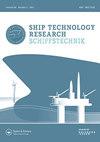Influence of ground effect on longitudinal aerodynamic damping of wing-in-ground effect vehicles
IF 0.9
Q3 ENGINEERING, MARINE
引用次数: 5
Abstract
ABSTRACT Accurate determination of longitudinal stability characteristics of wing-in-ground (WIG) effect vehicles is an essential step in their design. In order to estimate WIG vehicle’s stability, one needs to determine aerodynamic derivatives, including unsteady ones. The latter are very hard to obtain via wind tunnel tests, so traditionally they are expressed via steady derivatives. The method presented in this paper allows calculating unsteady aerodynamic derivatives by means of Reynolds-averaged Navier–Stokes simulations. The effect of different aerodynamic derivatives on stability characteristics is investigated. It is demonstrated that the decrement is two times greater in case of taking into account the unsteady aerodynamic derivatives calculated according to the presented method.地效对翼入地飞行器纵向气动阻尼的影响
准确确定地效机翼飞行器的纵向稳定性特性是其设计的重要步骤。为了估计WIG车辆的稳定性,需要确定空气动力学导数,包括非定常导数。后者很难通过风洞试验获得,因此传统上它们是通过稳定导数表示的。本文提出的方法允许通过雷诺平均Navier-Stokes模拟来计算非定常气动导数。研究了不同气动导数对稳定性特性的影响。结果表明,在考虑根据所提出的方法计算的非定常气动导数的情况下,衰减率是原来的两倍。
本文章由计算机程序翻译,如有差异,请以英文原文为准。
求助全文
约1分钟内获得全文
求助全文

 求助内容:
求助内容: 应助结果提醒方式:
应助结果提醒方式:


